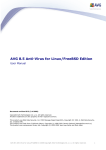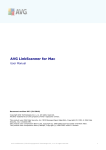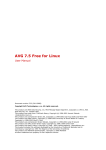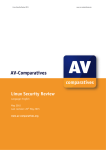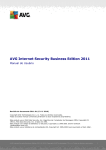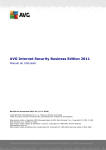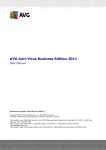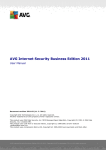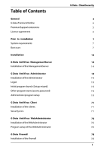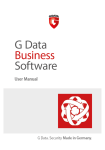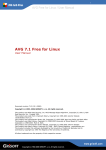Download User Manual
Transcript
AVG 2011 Anti-Virus for Linux/FreeBSD Edition User Manual Document revision 2011.1 (10/17/2011) C opyright AVG Technologies C Z, s.r.o. All rights reserved. All other trademarks are the property of their respective owners. This product uses RSA Data Security, Inc. MD5 Message-Digest Algorithm, C opyright (C ) 1991-2, RSA Data Security, Inc. C reated 1991. This product uses code from C -SaC zech library, C opyright (c) 1996-2001 Jaromir Dolecek ([email protected]). This product uses compression library zlib, C opyright (c) 1995-2002 Jean-loup Gailly and Mark Adler. A V G 2 0 1 1 A nti- V irus for L inux/FreeBSD © 2 0 1 1 C opyright A V G T ec hnologies C Z, s .r.o. A ll rights res erved. 1 Contents ........................................................................................................................ 3 1. Introduction 1.1 Features.......................................................................................................... 3 .......................................................................................................... 3 1.2 Prerequisities .......................................................................................................... 3 1.3 Prerequisites for the E-mail Server Edition .......................................................................................................... 4 1.4 Installation Package ........................................................................................................................ 5 2. Installation and Launch .......................................................................................................... 5 2.1 Distributions Currently Supported .......................................................................................................... 5 2.1.1 Using rpm , de b pa c ka ge s .......................................................................................................... 5 2.1.2 Using sh a rc hiv e .......................................................................................................... 5 2.1.3 Using t a r.gz a rc hiv e .......................................................................................................... 7 2.2 The Installation Process .......................................................................................................... 8 2.3 Product Registration 8 2.4 Installed .......................................................................................................... Directory Tree ........................................................................................................................ 10 3. On-access Scanner 10 3.1 RedirFS .......................................................................................................... Anti-Virus Filter 10 3.2 Dazuko .......................................................................................................... and DazukoFS Kernel Modules ........................................................................................................................ 11 4. Command Line Tools .......................................................................................................... 11 4.1 AVGSCAN Command .......................................................................................................... 12 4.2 AVGUPDATE Command ........................................................................................................................ 14 5. Configuration 14 5.1 General .......................................................................................................... Configuration 15 5.2 Logging.......................................................................................................... Configuration .......................................................................................................... 16 5.3 Scheduler Configuration 18 5.4 Update .......................................................................................................... Configuration ........................................................................................................................ 20 6. E-mail Scanner .......................................................................................................... 20 6.1 Features .......................................................................................................... 20 6.1.1 Ope n Sourc e E-m a il Se rv e rs Support e d 20 6.1.2 Ot.......................................................................................................... he r Engine s Support e d ........................................................................................................................ 21 7. Uninstallation ........................................................................................................................ 22 8. FAQ and Technical Support A V G 2 0 1 1 A nti- V irus for L inux/FreeBSD © 2 0 1 1 C opyright A V G T ec hnologies C Z, s .r.o. A ll rights res erved. 2 1. Introduction This User Manual is the full documentation describing AVG 2011 Anti-Virus for Linux/ FreeBSD. It covers all Linux/FreeBSD editions of the AVG product. 1.1. Features Kernel Features The AVG 2011 Anti-Virus for Linux/FreeBSD kernel provides comprehensive and reliable protection against viruses for Linux powered machines. It offers many features, such as scheduled and on-demand scanning of folders, files, and common archive types for possible virus infection. You can also perform a scheduled or on-demand update of your AVG either from the Internet or from local update sources. Command Line Modules Powerful standalone command line modules are included in all editions of AVG 2011 Anti-Virus for Linux/FreeBSD. You can perform all possible on-demand file system tests and updates using these modules. E-mail Scanning Features The incoming and outgoing e-mail messages processed by the supported mail transport agents (MTA) are monitored by constantly running the AVG process (memory resident scanning daemon). This means the e-mail spooling queues are protected and scanned regularly by AVG 2011 E-mail Server Edition for Linux/FreeBSD. The e-mail scanning performance can be easily controlled and configured using AVG 2011 AntiVirus for Linux/FreeBSD daemon signals and comprehensive configuration file parameters. Spam can be filtered using the integrated antispam engine. Infected emails can be moved into quarantine for further processing. 1.2. Prerequisities AVG 2011 Anti-Virus for Linux/FreeBSD requires library libc.so.6 or newer (both Linux and FreeBSD platforms). Newly supported a m d64 architecture requires lib32 compatible libraries. 1.3. Prerequisites for the E-mail Server Edition One of the supported open-source ( s e ndm a il, qm a il, e xim , po s tfix) e-mail servers must be installed (see chapter Features and Supported Mail Servers for details). A V G 2 0 1 1 A nti- V irus for L inux/FreeBSD © 2 0 1 1 C opyright A V G T ec hnologies C Z, s .r.o. A ll rights res erved. 3 1.4. Installation Package AVG 2011 Anti-Virus for Linux/FreeBSD installation packages are available on the installation CD in the form of rpm , de b, or sh packages for various Linux distributions, or in the form of a precompiled t a r.gz package for Linux and FreeBSD. You can also download the latest appropriate package version from http://www.avg.com, D o wnlo a d/ Pro gra m s section. A V G 2 0 1 1 A nti- V irus for L inux/FreeBSD © 2 0 1 1 C opyright A V G T ec hnologies C Z, s .r.o. A ll rights res erved. 4 2. Installation and Launch AVG 2011 Anti-Virus for Linux/FreeBSD installation packages are provided as rpm or deb files, and as tar.gz or sh archives. Please note that upgrading the old AVG fo r Linux/ Fre e B SD v e rs io n 9 to the ne w v e rs io n 2011 is not possible. You will have to uninstall AVG 9 manually (via /opt/ grisoft/avg9/bin/uninstall.sh) prior to installing AVG 2011. 2.1. Distributions Currently Supported Distribution Any Linux distributions supporting the rpm packager utility Any Linux distributions using the Debian packaging system Installation package a v g2011lm s - {re le a s e }- {v e rs io n}.{pla tfo rm }.rpm a v g2011lm s - {re le a s e }- {v e rs io n}.{pla tfo rm }.de b Any standard Linux a v g2011lm s - {re le a s e }- {v e rs io n}.{pla tfo rm }.s h distribution including those not supporting de b or rpm installations (Slackware, Gentoo etc.); re c om m e nde d inst a lla t ion pa c ka ge Any Linux distribution including those not supporting de b or rpm installations (Slackware, Gentoo etc.) a v g2011lm s - {re le a s e }- {v e rs io n}.{pla tfo rm }.ta r.gz FreeBSD a v g2011fm s - {re le a s e }- {v e rs io n}.{pla tfo rm }.ta r.gz Package name consist of: a v g2011{o pe ra ting s y s te m }m s - {re le a s e }- {v e rs io n}. {pla tfo rm }.{pa cka ge ty pe }. Example: avg2011lms-r285-a2582.i386.tar.gz Ple a se not e t ha t a pa rt from t he i386 pla t form , a m d64 is c urre nt ly a lso support e d. 2.1.1. Using rpm, deb packages The rpm and de b installation packages extract files directly into installed directory. For installation from the rpm file (Linux only), use the following command in your shell (accessible for example using the xt e rm application within your X window system): A V G 2 0 1 1 A nti- V irus for L inux/FreeBSD © 2 0 1 1 C opyright A V G T ec hnologies C Z, s .r.o. A ll rights res erved. 5 rpm –Uvh avg-2011.{release}-{version}.{platform}.rpm For installation from the deb file (Linux only), use the following command in your shell (accessible for example using the xt e rm application within your X window system): dpkg –i avg-2011.{release}-{version}.{platform}.deb No te : Y ou c a n a lso use a pa c ka ge m a na ge r suc h a s Y UM , a ptitude , Z ippe r e t c . for inst a lla t ion from t he loc a l sourc e . After installation, you will need to register your AVG; see chapter Product registration for details. 2.1.2. Using sh archive The .sh archive is created by Makeself 2.1.5, utility for building self-extractable archives on Unix. For details see homepage at: http://megastep.org/makeself/ If you downloaded the .sh archive via a web browser, you have to set the executable rights first: chmod +x avg2011lms-{release}-{version}.{platform}.sh To launch the installation, it is sufficient to run the self-extractable archive as a root: ./avg2011lms-{release}-{version}.{platform}.sh This will check the archive integrity and free space on harddisk, extract itself to a temporary directory /tmp, run the install script, and prompt the user to do the following: Agree AVG installation, Confirm License agreement, Confirm detected platform, Specify user under which avg should run (the default user is ro o t), Specify group under which avg should run (the default group is bin), Confirm creating a new directory / o pt/ a v g/, Decide whether README should be displayed after installation, Enter license number for product registration (this step can be skipped and performed later on, see chapter Product Registration). To skip all mentioned questions, and set the defaults during the installation, use: ./avg85lms-{release}-{version}.{platform}.sh -- -y A V G 2 0 1 1 A nti- V irus for L inux/FreeBSD © 2 0 1 1 C opyright A V G T ec hnologies C Z, s .r.o. A ll rights res erved. 6 2.1.3. Using tar.gz archive The installation process is identical to using the .sh archive; only some manual steps are required. For installation from the .tar.gz package, use the following commands (in the directory where the package is located) to unpack its contents, change directory and then finally run the install script (as root): For Linux, proceed with these steps: tar xzvf avg2011lms-{release}-{version}.{platform}.tar.gz cd avg2011lms-{release}-{version}.{platform} ./install.sh For FreeBSD, proceed with these steps: tar xzvf avg2011fms-{release}-{version}.{platform}.tar.gz cd avg2011fms-{release}-{version}.{platform} ./install.sh During installation, you will be prompted to do the following: Agree AVG installation, Confirm License agreement, Confirm detected platform, Specify user under which avg should run (the default user is ro o t), Specify group under which avg should run (the default group is bin), Confirm creating a new directory / o pt/ a v g/, Decide whether README should be displayed after installation, Enter license number for product registration (this step can be skipped and performed later on, see chapter Product Registration). To skip all mentioned questions, and set the defaults during the installation, use: ./install.sh -y 2.2. The Installation Process The installation process will automatically determine all features of your system and will perform the proper installation of AVG 2011 Anti-Virus for Linux/FreeBSD on your computer. Perform installation from the packages mentioned in the table above to install the AVG 2011 Anti-Virus for Linux/FreeBSD command line modules - besides the e-mail scanning daemons (se e c ha pt e r AVGSCAN Command for de t a ile d A V G 2 0 1 1 A nti- V irus for L inux/FreeBSD © 2 0 1 1 C opyright A V G T ec hnologies C Z, s .r.o. A ll rights res erved. 7 inform a t ion on t his t opic ). 2.3. Product Registration After the installation process you need to register your AVG 2011 Anti-Virus for Linux/FreeBSD unless it has been registered already during the installation process; this applies to special packages for AVG 2011 Anti-Virus for Linux/FreeBSD vendor partners. The registration can be performed by launching the following command in your shell (se e c ha pt e r AVGSCAN Command for m ore de t a ils): sudo avgctl -–register <your license number> 2.4. Installed Directory Tree The program files of the AVG 2011 Anti-Virus for Linux/FreeBSD are installed into the / opt/avg/avg8 directory. Symbolic links are created into /usr/bin on linux or /usr/local/ bin on FreeBSD, leading to the /opt/avg/avg10 directory subtree. Symbolic links for init script are instaled in various system directories: RedHat, Mandriva, Debian, Ubuntu, Gentoo: /etc/init.d/avgd Slackware: /etc/rc.d/rc.avgd FreeBSD: /usr/local/etc/rc.d/avgd.sh No te : The default user is root, and the default group is bin (not avg as in version 9). For running most commands (except AVGSCAN), you need to have superuser rights. No te : For running a binary directly, use the symlink to command line: sudo avgctl --start This will run the AVG8INSTDIR/bin/avgwrapper.sh script via the symbolic link avgctl in / usr/bin/. The script will export environment variables, and run the binary specified by the symlink name. The structure and contents of / o pt/ a v g/ a v g10 are as follows: /opt `-- avg `-- avg10 |-- bin binaries (daemons and utilities), avgwrapper.sh script, uninstall.sh script (only for sh or t a r.gz package) |-- cfg binary configuration files A V G 2 0 1 1 A nti- V irus for L inux/FreeBSD © 2 0 1 1 C opyright A V G T ec hnologies C Z, s .r.o. A ll rights res erved. 8 |-- doc README, license |-- etc text configuration files | `-- init.d init scripts |-- lib AVG libraries |-- log logging directory |-- man man pages | |-- man1 | `-- man5 |-- update temporary directories containing update data (cft and bin differences files), backup of the data etc. `-- var |-- antispam antispam and SpamCatcher configuration (blacklist, whitelist), spam definitions |-- data license (snu), virus definitions (avi) `-- run pid and pipe files (only present if avgd is running), dump files (if AVG crashed previously) A V G 2 0 1 1 A nti- V irus for L inux/FreeBSD © 2 0 1 1 C opyright A V G T ec hnologies C Z, s .r.o. A ll rights res erved. 9 3. On-access Scanner In order to enable the on-access scanning using the AVG 2011 Anti-Virus for Linux/ FreeBSD engine, you need to have at least one of the following installed on your computer: R e dirFS Anti- Virus Filte r is a preferred solution for Linux/GNU OS running Linux kernel version 2.6.25 and higher. On how to obtain and install these, refer to the following chapter. D a z uko ke rne l m o dule can be used for FreeBSD and Linux/GNU running Linux kernel 2.2, 2.4, and 2.6. D a z uko FS ke rne l m o dule , a newer version of Dazuko which will be discontinued; the future development is aimed to DazukoFS only. 3.1. RedirFS Anti-Virus Filter Redirecting FileSystem (RedirFS) project aims to be general, fast, flexible open source framework allowing to redirect native filesystem calls in the VFS layer. It is implemented as a LKM (Linux Kernel Module), and provides well defined interface for other LKMs which are called Filters. The latest version of RedirFS Anti-Virus Filter can be downloaded from http://www.redirfs.org. Installation of RedirFS Anti-Virus Filter is currently only possible from source code: Since there is no general source code package for Anti-Virus Filter, redirfs, libraries and user-space utilities, it is necessary to download and install each component separately. (This is because not all components need to be installed.) For detailed instructions, please refer to INSTALL and README files shipped within each install tar. gz file, or see http://www.redirfs.org. 3.2. Dazuko and DazukoFS Kernel Modules The latest version of DAZUKO or DazukoFS (referring to as DAZUKO only in the following text) can be downloaded from http://www.dazuko.org. It is recommended to download the latest version available, especially if you are running the kernel of major version 2.6. If you run the kernel of higher version, it is recommended to use the R e dirFS Anti- Virus Filte r instead. To install the DAZUKO kernel module, follow the instructions provided on DAZUKO homepage ( Inst a lla t ion_HOWT O). Once the DAZUKO module is installed and inserted, the AVG 2011 Anti-Virus for Linux/FreeBSD daemons responsible for the on-access scanning will be fully functional. A V G 2 0 1 1 A nti- V irus for L inux/FreeBSD © 2 0 1 1 C opyright A V G T ec hnologies C Z, s .r.o. A ll rights res erved. 10 4. Command Line Tools All command-line utilities are run by symbolic links (in /usr/bin) to a v gwra ppe r.s h script. The script exports the necessary environment variables, and runs the respective binary. Binaries should be used under the user the AVG product is installed under (default "root"). Any action launched via command-line can be aborted by CTRL+c, however, this will not work if a component executes a critical action (breaking a critical action is NOT recommended), e.g. during update when setting new configuration. Ple a s e no te tha t a ny m ultis tring v a lue s m us t be put into quo ta tio n m a rks . Common parameters: -h, --help Display help. -v, --version Display version. 4.1. AVGSCAN Command The a v gs ca n binary is intended to perform various on-demand tests via a v gd daemon. Its performance is comprehensively controlled by the command line parameters. All scans are run multi-thread and independent, therefore it is possible to run more than one scan at a time; however scanning performance will not be increased this way. No te : If t he re is no sha re d m e m ory a v a ila ble , m e m ory usa ge w ill inc re a se w it h e a c h pa ra lle l running sc a n proc e ss. It is HIGHLY re c om m e nde d t ha t sha re d m e m ory is e na ble d on t he sy st e m , e spe c ia lly for se rv e r inst a lla t ion. Ena bling sha re d m e m ory (on bot h Linux a nd F re e BSD): sysctl kernel.shmmax=<shared memory size> Options: -x, --exclude=<path> Exclude path from scan. Multiple --exclude options can be specified. -e, --ext=<extension> Scan files with specified extension. Multiple --ext options can be specified. Cannot be used with --noext. -n, --noext=<extension> Exclude files with specified extension. Multiple --noext options can be specified. Cannot be used with --ext. --ignerrors Do not report object scan errors. -H, --heur Use heuristic analysis for scanning. -p, --pup Scan for potentially unwanted programs. A V G 2 0 1 1 A nti- V irus for L inux/FreeBSD © 2 0 1 1 C opyright A V G T ec hnologies C Z, s .r.o. A ll rights res erved. 11 -c, --coo Scan cookies. -i, --hidext Recognize hidden extensions. -m, --macrow Report documents with macros. -o, --repok Report also clean files. -w, --pwdw Report password protected files. -b, --arcbombsw Report archive bombs. -M, --media Scan media files. -B, --boot-sector Scan boot sector. -r, --report=<filename> Save scan report to specified file. -a, --arc Scan inside archives. -d, --debug Verbose mode. Multiple -d options increase verbosity. Maximum value is 3. 4.2. AVGUPDATE Command Anti-virus systems can guarantee reliable protection only if they are updated regularly. AVG 2011 Anti-Virus for Linux/FreeBSD provides a reliable and fast update service with quick response times via a v gupd daemon. Options: -b, --no-backup Do not backup old files. -a, --no-daemons Do not restart any AVG daemon processes. -download Only download and check update files to a folder specified by -path option. -n, --no-progress Do not display progress information. --path="xy" Update folder (used if the update source is a folder, or with -d option). Quotation marks are obligatory. -p, --priority NUM NUM represents the type of update: 2 - Virus update 3 - Program update 4 - Optional update (default) A V G 2 0 1 1 A nti- V irus for L inux/FreeBSD © 2 0 1 1 C opyright A V G T ec hnologies C Z, s .r.o. A ll rights res erved. 12 --source=[inet/ folder] inet - Update from the Internet or network (default). folder - Update from folder. --url="xy" Update URL (used only if the update source is inet). If not specified, the pre-set value from config will be used. Quotation marks are obligatory. -s, --antispam Enable Anti-Spam update. A V G 2 0 1 1 A nti- V irus for L inux/FreeBSD © 2 0 1 1 C opyright A V G T ec hnologies C Z, s .r.o. A ll rights res erved. 13 5. Configuration For common configuration of AVG 2011 Anti-Virus for Linux/FreeBSD, there are no configuration files. Instead, configuration is managed by a configuration subsystem which consists of: libavgcfg.so library (placed in /opt/avg/avg10/lib/) dfncfg.dat containing default configuration (placed in /opt/avg/avg10/cfg) .cfg files containing values differing from default configuration (placed in /opt/ avg/avg10/cfg) a v gcfgctl utility designed to manage configuration items (placed in /opt/avg/ avg10/bin) 5.1. General Configuration The command line utility designed to easily manage AVG 2011 Anti-Virus for Linux/ FreeBSD configuration is a v gcfgctl. This utility supports the following operations: a ) D is pla y co nfigura tio n v a lue s This is a default action. If no parameter is specified, the complete AVG configuration will be displayed. Examples: avgcfgctl Oad.logging.public.verbosity displays only one configuration item avgcfgctl Oad.logging displays whole configuration of OAD logging avgcfgctl logging.public.verbosity displays specified value for all loggers avgcfgctl logging displays complete logging configuration for all loggers By default, all configuration items are displayed to stdout. For exporting configuration to a specified file, use -f option. b) Se t co nfigura tio n v a lue s If -w option specified, the values will be set instead of being displayed. New configuration values may be specified via commandline, or in a file specified by -f option. Syntax of these commands is as follows: avgcfgctl Oad.logging.public.verbosity=ALL will set OAD public logger verbosity to value ALL avgcfgctl logging.public.verbosity=ALL will set verbosity of all public loggers to value ALL A V G 2 0 1 1 A nti- V irus for L inux/FreeBSD © 2 0 1 1 C opyright A V G T ec hnologies C Z, s .r.o. A ll rights res erved. 14 Setting new configuration values will not trigger any immediate action in AVG components; to use the new configuration as soon as possible, use -n option which will notify all interested AVG components of the configuration change. The component then takes respective action. c) C he ck v a lid v a lue s Please note that only a passed value is checked. If you enter any undocumented value, it will be accepted, however the corresponding feature will malfunction! 5.2. Logging Configuration This chapter describes available loggers and their configuration items. All log files are stored in /opt/avg/avg10/log; mentioned filenames are referred to as names of the file only, without path specification. AVG log messages can be stored in four ways, plus any combination of them: 1. C o ns o le : The messages are sent to stderr. 2. Sy s lo g: The messages are sent to syslog. 3. File : The messages are sent to a file. All messages will be stored in the file (unlimited size). 4. R o lling file : The messages are sent to a rolling file. Filesize is limited; if the size is reached, current file is closed and stored, and a new file is created. Number of stored files is also configurable. Currently there are 10 dedicated loggers. Each AVG component has its own logger; one logger is common for all command-line utilities. Loggers names for use with avgcfgctl utility are as follows: 1. Upda te logger, used by AVG update 2. W D logger, used by WatchDog 3. Sche d logger, used by Scheduler 4. Av id logger, used by AviDaemon 5. Tcpd logger, used by Mail server 6. Sca nd logger, used by scanning engine 7. As pa m logger, used by antispam engine 8. O a d logger, used by on-access daemon 9. C li logger, used by all command-line utilities A V G 2 0 1 1 A nti- V irus for L inux/FreeBSD © 2 0 1 1 C opyright A V G T ec hnologies C Z, s .r.o. A ll rights res erved. 15 Configuration items of all loggers will be now listed. The '*' symbol has to be replaced by 'private' or 'public' thus configuring private or public loggers. Private loggers are encrypted AVG loggers, so there is no reason to set consolelog or syslog items to true. logging.*.verbosity (STRING) specifies verbosity of the logger. Available values are ERR, WARN, INFO, DEBUG, DETAIL, ALL. logging.*.consolelog (BOOL) specifies whether logs go to console. logging.*.syslog (BOOL) specifies whether logs go to syslog. logging.*.filelog (BOOL) specifies whether logs go to file. logging.*.filename (STRING) specifies name of the logging file. logging.*.rollog (BOOL) specifies whether private logs go to rolling file. logging.*.rolname (STRING) specifies name of the rolling file. logging.*.rolcount (DWORD) specifies maximum number of rolling files. logging.*.rolsize (FILESIZE) specifies maximum size of a rolling file. 5.3. Scheduler Configuration Currently there are the following schedulable tasks: 1. G lo ba lSca n task for a scheduled scan of selected areas. 2. Upda te Vir task for scheduled update with priority 2. (virus update) 3. Upda te As pa m task for scheduled update of antispam rules. 4. Upda te Pro gra m task for scheduled update with priority 2. (program update) 5. D a ily Pre v a le nce task for daily operation of XPL prevalence reporting. 6. E v e ntPre v a le nce task for an event operation of XPL prevalence reporting. All mentioned tasks have the following configuration items: sched.Task.Disabled (BOOL) specifies whether a task is disabled. sched.Task.StartType (DWORD) specifies start type of a task. Can contain the following values: 0 - starts the task only once at sched.Times.StartTime. 1 - starts the task repeatedly, every sched.Repeat.Interval units from sched.Repeat.BaseTime. A V G 2 0 1 1 A nti- V irus for L inux/FreeBSD © 2 0 1 1 C opyright A V G T ec hnologies C Z, s .r.o. A ll rights res erved. 16 2 - starts the task every day at sched.Times.StartTime. 3 - starts the task every week on sched.Times.DayOfWeek, at sched. Times.StartTime. 4 - starts the task at system startup, specifically, at AVG startup only (not after restore from hibernation etc.). 5 - starts the task every month on sched.Times.DayOfMoth day, at sched. Times.StartTime. 6 - starts the task only on selected days, sched.Times.SelectedDays, at sched.Times.StartTime. sched.Task.MissedStartAction (DWORD) specifies what to do if the start time of a task is missed. May contain value 0 meaning that missed start should be ignored; value 1 will start the missed task. sched.Times.StartTime (DATE) specifies start time for some StartTypes. sched.Times.DayOfWeek (DWORD) specifies a day of the week when a task should start. May contain values from 0 to 6 (0 for Sunday, 6 for Saturday). sched.Times.DayOfMonth (DWORD) specifies a day of the month when a task should start. sched.Times.GracePeriod (DWORD) specifies how long after system startup will a task be launched (in seconds). sched.Times.SelectedDays (DWORD) specifies selected days of the week on which a task should start, as a mathematical addition of following values: 1 Sunday, 2 - Monday, 4 - Tuesday, 8 - Wednesday, 16 - Thursday, 32 - Friday, 64 - Saturday. sched.Repeat.Type (DWORD) specifies units for Repeat.Interval. May contain 0, selecting minutes as unit for Repeat.Interval. Value 1 means hours. sched.Repeat.Interval (DWORD) specifies amount of units specified by Repeat.Type. sched.Repeat.BaseTime (DATE) specifies base time from which the Repeat. Interval will count. Not e : T he (DAT E) t y pe v a lue s a re in form a t Y Y Y Y -M M -DD/hh-m m -ss. There are three additional configuration items: sched.Task.ScanAfterUpdate (BOOL) specifies whether a scan should start after virus database update. sched.Update.Source (STRING) specifies whether update tasks should A V G 2 0 1 1 A nti- V irus for L inux/FreeBSD © 2 0 1 1 C opyright A V G T ec hnologies C Z, s .r.o. A ll rights res erved. 17 update from Internet (value "inet"), or a folder (value "folder"). sched.Update.Path (STRING) specifies path to the update folder if Update. Source is set to folder. These items appear in each task configuration, however, are only used where applicable. No te : Spe c ia l rule s for F REE lic e nse use rs: F REE lic e nse use rs c a nnot sc he dule Upda te As pa m , a nd c a n only sc he dule Upda te Pro gra m a nd Upda te Vir t o be pe rform e d onc e a da y . 5.4. Update Configuration These configuration items are used by all scheduled updates, and also as defaults for on-demand update (can be rewritten by command-line options). Update configuration contains the following items (default settings listed where applicable): Default.update.Inet.UpdateServerURL=|+http://update.avg.com/ softw/10/update/|+http://backup.avg.cz/softw/10/update/| specifies a list of available update servers. Each URL must begin with a plus sign; if the sign is missing, the URL will not be used. This allows disabling some of the defined servers without the need to delete them. Default.update.Inet.UpdateServerName=|update primary server| update backup server| specifies hint names for Inet.UpdateServerURL. Default.update.Inet.disconnect_speed_limit=500; if download speed goes below this value in B/s for a specified time, download is aborted. Default.update.Inet.disconnect_time_limit=300; if download goes below specified speed for time specified by this value, download is aborted. Default.update.Options.Proxy.Mode=0 specifies proxy mode. May contain the following values: 0 - do not use proxy. 1 - use proxy. 2 - try connection using proxy, and if it fails, connect directly. Default.update.Options.Proxy.Server (STRING) specifies proxy server. Default.update.Options.Proxy.Port=3128 specifies proxy port. Default.update.Options.Proxy.UseLogin=false specifies whether login to proxy is needed. Default.update.Options.Proxy.Login (STRING) specifies login name. A V G 2 0 1 1 A nti- V irus for L inux/FreeBSD © 2 0 1 1 C opyright A V G T ec hnologies C Z, s .r.o. A ll rights res erved. 18 Default.update.Options.Proxy.Password (STRING) specifies login password. Default.update.Options.Proxy.AuthenticationType=0 specifies proxy authentication type. May contain the following values: 0 - Any 1 - Basic The following options specify Antispam proxy settings: Default.aspam.proxy_authtype=auto specifies HTTP proxy authentication. Default.aspam.proxy_host (STRING) specifies HTTPS proxy host name and port number. Default.aspam.proxy_userpwd (STRING) specifies HTTPS proxy username and password. No te : T he M ULT IST RING t y pe it e m s a re in form a t "|st ring1|st ring2|st ring3|", a nd m ust be put int o t he quot a t ion m a rks. A V G 2 0 1 1 A nti- V irus for L inux/FreeBSD © 2 0 1 1 C opyright A V G T ec hnologies C Z, s .r.o. A ll rights res erved. 19 6. E-mail Scanner Connection of AVG to open sourced MTA's is described in the following chapters. However, if required/preferred, AVG can be connected to MTAs via third party interfaces. E-mail server configuration is done via a v gtcpd utility. 6.1. Features spam detection and filtering actions in case of virus detection e-mail certification subject certification of infected e-mails/spam e-mail notification in case of virus detection 6.1.1. Open Source E-mail Servers Supported sendmail – the traditional s e ndm a il mail transport agent (MTA, Linux synonym for lightweight e-mail server) is included in most modern Linux distributions. The latest version is also available for free at http://www. sendmail.org. qmail – the latest version is available for free at http://cr.yp.to/qmail.html; an extensive description of download, installation, and maintenance issues related to qm a il is also provided at http://www.lifewithqmail.org. postfix – the postfix MTA is a popular alternative to the widely used s e ndm a il e-mail server; the latest version is available for free at http://www.postfix.org/ . exim – this MTA can be also used as replacement for the common s e ndm a il e-mail server, although its configuration and maintenance principles differ; the latest version of the e xim e-mail server is available for free at http://www. exim.org. 6.1.2. Other Engines Supported AMaViS – A Mail Virus Scanner, information and installation instructions available at http://www.amavis.org/ A V G 2 0 1 1 A nti- V irus for L inux/FreeBSD © 2 0 1 1 C opyright A V G T ec hnologies C Z, s .r.o. A ll rights res erved. 20 7. Uninstallation How to uninstall AVG 2011 Anti-Virus for Linux/FreeBSD: The unins ta ll.s h script is created in a temporary and /opt/avg/avg8/bin directory during installation process from a sh or t a r.gz archive. It contains a list of created files, directories, and symlinks. It also contains uninstallation runlevel services which depend on the operating system detected during installation. For sh and tar.gz, run: sudo /opt/avg/avg10/bin/uninstall.sh For rpm, run: rpm –e avg-2011.{release}-{version}.{platform}.rpm For deb, run: sudo dpkg –r avg-2011.{release}-{version}.{platform}.deb A V G 2 0 1 1 A nti- V irus for L inux/FreeBSD © 2 0 1 1 C opyright A V G T ec hnologies C Z, s .r.o. A ll rights res erved. 21 8. FAQ and Technical Support The FAQ section of the AVG Technologies website (http://www.avg.com) provides answers to most issues that you may encounter while using AVG 2011 Anti-Virus for Linux/FreeBSD. If you do not find the solution of your problem in the FAQ section or documentation, contact the AVG technical support department via e-mail at technicalsupport@avg. com. Providing the following information in the e-mail will help our technical support to give you a quick and comprehensive response: version of your AVG 2011 Anti-Virus for Linux/FreeBSD your distribution of Linux (or other UNIX based system version) your AVG license number A V G 2 0 1 1 A nti- V irus for L inux/FreeBSD © 2 0 1 1 C opyright A V G T ec hnologies C Z, s .r.o. A ll rights res erved. 22






















